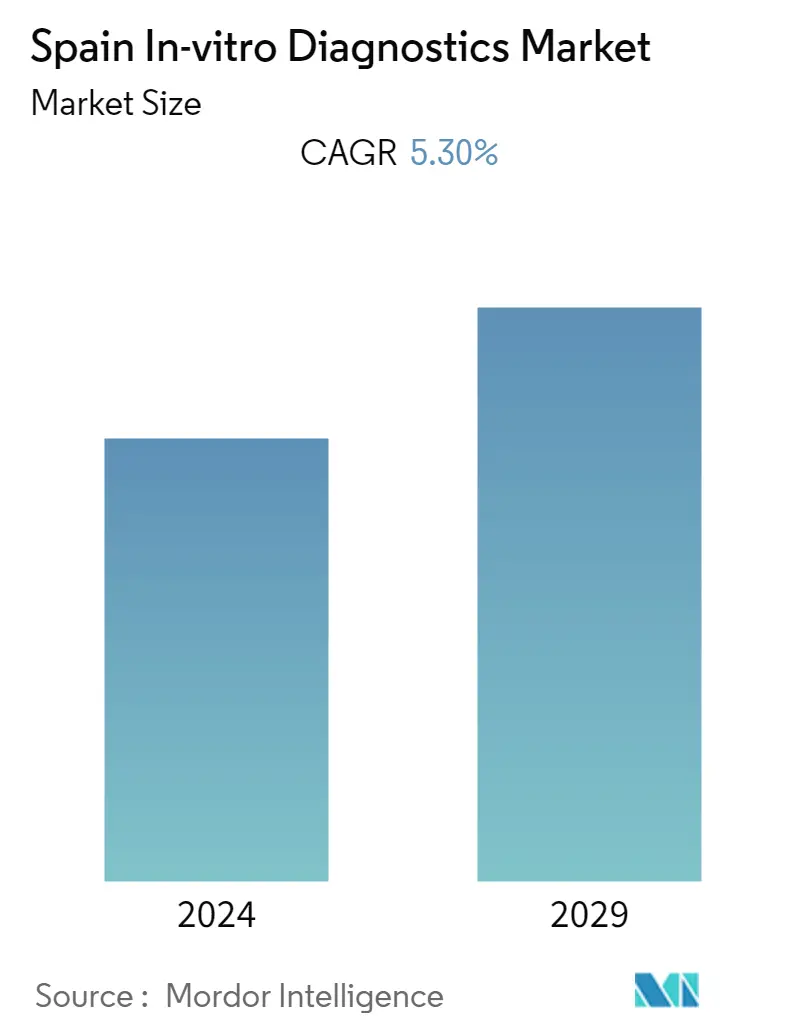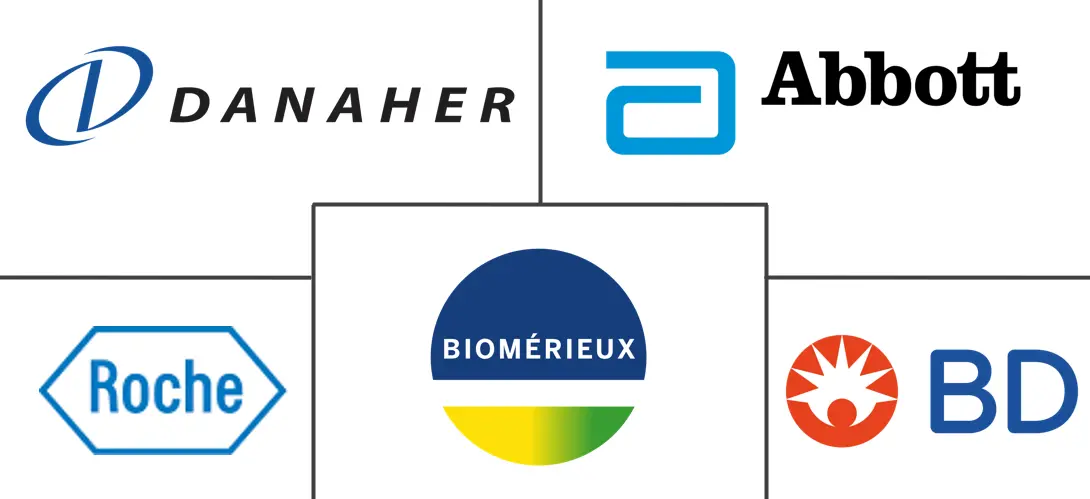Market Size of Spain In-vitro Diagnostics Industry

| Study Period | 2019 - 2029 |
| Base Year For Estimation | 2023 |
| Forecast Data Period | 2024 - 2029 |
| Historical Data Period | 2019 - 2022 |
| CAGR | 5.30 % |
Major Players
*Disclaimer: Major Players sorted in no particular order |
Spain In-Vitro Diagnostics Market Analysis
The Spain In-Vitro Diagnostics Market is expected to grow at a CAGR of 5.3% over the forecast period (2022-2027).
The ongoing Covid-19 pandemic impacted the studied market significantly. During the initial phase of the pandemic due to the lockdowns and shutdowns, the market was impacted adversely. However, owing to the increasing demand for testing and diagnosis of Covid-19 infection, and increasing cases of chronic disease in Spain, the in-vitro diagnostics market is predicted to witness steady growth. The government initiatives in response to Covid-19 are increasing recently. For instance, in June 2022, the World Health Organization (WHO)'s COVID-19 Technology Access Pool (C-TAP) and the South African business Biotech Africa signed a new license deal for a COVID-19 antibody test through the Medicines Patent Pool (MPP). The new deal expands upon the first non-exclusive licensing agreement with Spanish National Research Council (CSIC) announced by WHO and MPP in 2020. Thus, owing to the factors stated above, the pandemic is expected to considerably impact the market studied.
Factors such as the rising prevalence of chronic diseases and the increasing use of point-of-care (POC) diagnostics and the growth in the occurrence of cancer and heart diseases remain the key driver of the studied market. For instance, the Global Cancer Observatory data updated in March 2022 mentioned that around 282,421 new cancer cases were diagnosed in Spain in 2020. In addition, as per the International Diabetes Federation (IDF) data updated in November 2021, Spain has the second highest diabetes prevalence in Europe with 1 in 7 adults living with diabetes, and more than 5 million adults in the country are affected by the condition. Hence, the country's demand for early diagnostics for disease detection is expected to increase. And this is anticipated to drive the in-vitro diagnostics, driving the market growth in Spain.
Moreover, the major players in the country are actively focused on the innovation of technically advanced products which can be beneficial to the target population in the country for disease detection and treatment. Additionally, government investments are increasing in the country. For instance, in June 2021, the Government of Spain planned to invest nearly 400 million euros for the fiscal year in the development of the High-End Technology Equipment Investment Plan (INVEAT) of the National Health System (SNS) to meet in a planned and orderly way the needs of SNS. The portfolio of equipment to be renewed or expanded includes linear accelerators, CT, magnetic resonance imaging, PET-CT, gamma cameras, digital brachytherapy equipment, vascular angiographs, neuroradiology angiographs, and catheterization laboratories. Thus, such developments are anticipated to fuel market growth in the country.
Therefore, the increasing chronic diseases in the country and the availability of technically advanced products are expected to boost the in-vitro diagnostics market in Spain. However, strict regulations and irregular reimbursement policies are expected to hinder market growth over the studied period.
Spain In-Vitro Diagnostics Industry Segmentation
As per the scope of this report, in vitro diagnostics involves medical devices and consumables that are utilized to perform in vitro tests on various biological samples. They are used for the diagnosis of various medical conditions, such as infectious diseases, cardiovascular diseases, diabetes, and cancer, among other diseases. The Spain In-Vitro Diagnostics Market is segmented by Test Type (Clinical Chemistry, Molecular Diagnostics, and Other Techniques), Product (Instrument, Reagent, and Other Products), Usability (Disposable IVD Devices and Reusable IVD Devices), Application (Infectious Disease, Diabetes, Cancer, Cardiology, Autoimmune Diseases and Other Applications), and End-users (Diagnostic Laboratories, Hospitals and Clinics and Other End-users). The report offers the value (in USD million) for the above segments.
| By Test Type | |
| Clinical Chemistry | |
| Molecular Diagnostics | |
| Other Types |
| By Product | |
| Instrument | |
| Reagent | |
| Other Products |
| By Usability | |
| Disposable IVD Devices | |
| Reusable IVD Devices |
| By Application | |
| Infectious Disease | |
| Diabetes | |
| Cancer | |
| Cardiology | |
| Autoimmune Diseases | |
| Other Applications |
| By End Users | |
| Diagnostic Laboratories | |
| Hospitals and Clinics | |
| Other End Users |
Spain In-vitro Diagnostics Market Size Summary
The in-vitro diagnostics market in Spain is poised for steady growth, driven by the increasing prevalence of chronic diseases and the rising demand for point-of-care diagnostics. The market experienced initial setbacks due to the Covid-19 pandemic, but the subsequent surge in testing and diagnosis needs, along with government initiatives, has bolstered its recovery. The focus on early disease detection, particularly in cancer and diabetes, is a significant factor propelling market expansion. Additionally, advancements in molecular diagnostics, including the use of PCR-based methods and next-generation sequencing, are contributing to the market's growth trajectory. The competitive landscape is marked by the presence of both global and domestic players, with ongoing innovations and strategic partnerships further enhancing market dynamics.
Government investments in high-end technology and equipment, such as CT and MRI machines, are expected to support the market's development. The Spanish government's commitment to improving the National Health System through substantial financial allocations underscores the importance of advanced diagnostic tools. Despite the positive growth outlook, challenges such as stringent regulations and irregular reimbursement policies may impede market progress. Nonetheless, the continuous engagement of market players in mergers, acquisitions, and collaborations, along with the introduction of new products, is anticipated to drive the in-vitro diagnostics market forward in Spain over the forecast period.
Spain In-vitro Diagnostics Market Size - Table of Contents
-
1. MARKET DYNAMICS
-
1.1 Market Overview
-
1.2 Market Drivers
-
1.2.1 High Burden of Chronic and Infectious Diseases
-
1.2.2 Increasing Use of Point-of-care (POC) Diagnostics
-
1.2.3 Growing Demand for Rapid Tests and Advanced Technologies in Healthcare Facilities
-
-
1.3 Market Restraints
-
1.3.1 Stringent Regulations
-
1.3.2 Irregular Reimbursement Policies
-
-
1.4 Porter's Five Forces Analysis
-
1.4.1 Threat of New Entrants
-
1.4.2 Bargaining Power of Buyers/Consumers
-
1.4.3 Bargaining Power of Suppliers
-
1.4.4 Threat of Substitute Products
-
1.4.5 Intensity of Competitive Rivalry
-
-
-
2. MARKET SEGMENTATION (Market Size by Value - USD million)
-
2.1 By Test Type
-
2.1.1 Clinical Chemistry
-
2.1.2 Molecular Diagnostics
-
2.1.3 Other Types
-
-
2.2 By Product
-
2.2.1 Instrument
-
2.2.2 Reagent
-
2.2.3 Other Products
-
-
2.3 By Usability
-
2.3.1 Disposable IVD Devices
-
2.3.2 Reusable IVD Devices
-
-
2.4 By Application
-
2.4.1 Infectious Disease
-
2.4.2 Diabetes
-
2.4.3 Cancer
-
2.4.4 Cardiology
-
2.4.5 Autoimmune Diseases
-
2.4.6 Other Applications
-
-
2.5 By End Users
-
2.5.1 Diagnostic Laboratories
-
2.5.2 Hospitals and Clinics
-
2.5.3 Other End Users
-
-
Spain In-vitro Diagnostics Market Size FAQs
What is the current Spain In-vitro Diagnostics Market size?
The Spain In-vitro Diagnostics Market is projected to register a CAGR of 5.30% during the forecast period (2024-2029)
Who are the key players in Spain In-vitro Diagnostics Market?
Becton, Dickinson and Company, Bio-Rad Laboratories Inc., F. Hoffmann-La Roche AG, Danaher and bioMeriux are the major companies operating in the Spain In-vitro Diagnostics Market.

